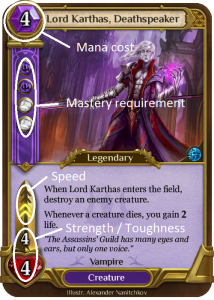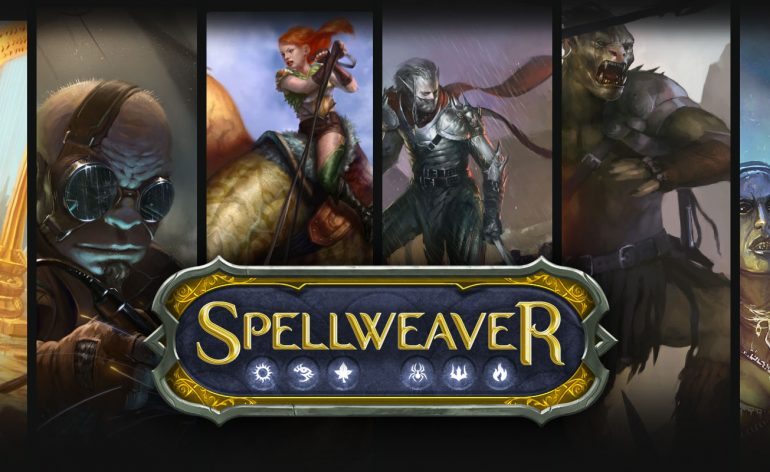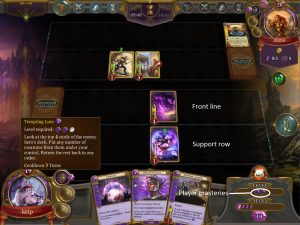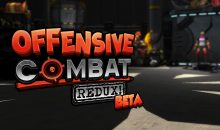Preview: Spellweaver TCG
I’ve recently spent a bit of time playing around in an upcoming digital card game called Spellweaver. Much like the highly popular Hearthstone, it’s set to be released as a free to play game that allows for purchases of card packs using in-game currencies. Unlike Hearthstone’s rigid class system, Spellweaver emphasizes deck building based around six disparate elements that can be played alone or combined to create that perfect synergy to fit a particular play style. For those seeking an online card game that demands more strategy than luck, Spellweaver is waiting for you.
Spellweaver plays like a more nuanced version of Magic the Gathering. If you’re familiar with Magic, many of the core concepts in Spellweaver will feel like second nature. Many of the card types draw parallels with Magic. Creatures are just like creatures (okay, that was straightforward), spell cards act like sorcery cards (playable only on your turn and cannot interrupt other spells or combat actions), instants act like instants (can be cast at any time including during combat), and shrines act somewhat like lands (more about that later). There are, however, a number of important differences that you should know about.
Board layout
The creature area of the play field is separated into a front row and a support row. Creatures in the front row can attack, block, and be attacked. Those in the support row cannot (with the exception of flying creatures), but they can still use any special powers they might have. Moving a creature between rows will exhaust it, so be sure to choose wisely when deciding where to place a newly summoned creature.
Resources
In order to cast spells, summon creatures, or use hero abilities, you need to make sure you have the proper resources. In Spellweaver, those resources are broken down into two basic types: masteries and mana. Masteries represent the level of power within a certain magical discipline (most easily denoted by color). Some cards require only a level one mastery while others may require something more complex like two levels of a specific color mastery plus one additional from any other color. Masteries are distinct from mana in that they aren’t expended in order to cast a spell, they represent the power to do so. Mana is the expendable resource used each turn in order to cast more spells. Mana is not color specific and could be used to cast any card for which a player has the proper mastery level. You must have both the appropriate masteries and the available mana in order to cast a spell.
Shrines
Shrines, like basic lands in Magic, are the backbone of your deck in Spellweaver. You may play only one shrine per turn. Doing so with a basic shrine will provide the option of permanently increasing your mana pool by one and drawing a card or permanently gaining one level of mastery for that shrine’s color. Players start each game with no masteries and a mana pool of one. There are special shrines that allow the player to gain a hero ability instead of drawing a card when choosing the mana option. Decks simply do not function without a generous amount of these cards.
Speed
 All creatures in Spellweaver have a strength stat and a toughness stat much like creatures in Magic. (As opposed to the cumulative, persistent damage of hit points in Hearthstone.) Where Spellweaver differs is in a third stat called speed. Speed can range from 0 to 4 and will heavily influence play strategy. Creatures may only choose to attack or block other creatures with an equal or lesser speed rating. This is highly important because defending players can choose to assign blockers during combat as long as those creatures can match or beat the speed of attacking enemies. Otherwise, those enemies can go right around them with ease. A creature that has had its speed reduced to 0 cannot attack or defend.
All creatures in Spellweaver have a strength stat and a toughness stat much like creatures in Magic. (As opposed to the cumulative, persistent damage of hit points in Hearthstone.) Where Spellweaver differs is in a third stat called speed. Speed can range from 0 to 4 and will heavily influence play strategy. Creatures may only choose to attack or block other creatures with an equal or lesser speed rating. This is highly important because defending players can choose to assign blockers during combat as long as those creatures can match or beat the speed of attacking enemies. Otherwise, those enemies can go right around them with ease. A creature that has had its speed reduced to 0 cannot attack or defend.
Heroes
Similar to Hearthstone, Spellweaver is built around specific heroes. Each hero starts with one unique power, but they aren’t limited to just that ability. During the course of a match, a hero is allowed to gain two additional hero abilities through the use of specific shrine cards. This allows for highly flexible customization of play style, especially in a multicolor deck. Hero abilities do, however, have casting requirements similar to spells and may take a while to be useful. So it’s important to be sure to include shrines that will add a good amount of variety to the default hero ability option.
For example: Despina, a dominion (purple) hero, starts with the ability to look at the top four cards of an opponent’s deck and put any number of creatures found into play under her control. The down side is that this ability requires a level three mastery (two dominion, one additional of any type) and costs five mana. Without the aid of additional spells and resources, this means the power couldn’t be used until at least turn seven. It then has a three round cooldown.
Alternate win conditions
Every duel style card game allows for determining a winner when they overwhelm their opponent and reduce their life points down to zero (or less if you’re really into the overkill thing). Spellweaver doesn’t limit victory to brute force. If you manage to wear down your opponent until they run out of cards, you immediately win. You can also win by boosting your own life up to 40. So there are viable game strategies beyond HULK SMASH.
My first impressions
All of these new mechanics are amazing and add to the depth of play strategy. I also love the unique flavor of each of the six magic disciplines (order, wisdom, nature, corruption, dominion, rage). The card artwork in the game is fantastic and really reminds me of why I got into Magic all those years ago. There’s also a searchable card database available on their site that I found helpful while trying to build some deck synergy. To top it off, I love the variety of choice that comes from the the quest system in the game to help gain more currency or even packs of cards on a daily basis. Spellweaver takes what made Magic great as a physical game and raises it to the next level in digital format.
All of that said, I’ve found that I really don’t have the constitution to stick with a CCG that relies heavily on resource management like this. Even with the option to sacrifice a card from my hand to look at the top five cards in my deck and draw a shrine from them, the randomness of power progression drives me nuts. Spellweaver does an excellent job of recreating a card game based on those resources, it just doesn’t grab me as a player anymore. It’s one of the reasons I haven’t gone back to Magic since… let’s just say it’s been a while.
For anyone that loves deck building and strategy heavy card games, I highly recommend giving Spellweaver a chance. Spellweaver is hitting open beta toward the end of April and has already been greenlit on Steam. If you’re really interested in playing and don’t want to wait until open beta, you can go to their support page and donate toward something you want to see added to the game and also gain access to the beta right now. With upcoming features like card crafting, a fame mechanic, and Spellweaver trials (think Hearthstone’s arena mode), this is going to be a game to watch closely.







